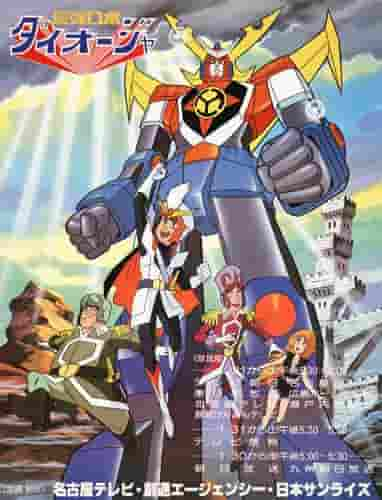The appeal and review of "The Strongest Robo Daiohja": A must-see mecha action masterpiece

"The Strongest Robo Daiohja": A fusion of period drama and robot anime"The Strongest Robo Daiohja" is a TV anime series that aired from 1980 to 1981 on Nagoya TV, every Saturday from 5:30 to 6:00 PM. The series consists of 50 episodes, each 30 minutes long. It was written by Hajime Yatate, directed by Katsutoshi Sasaki, and produced by Nagoya TV, Sotsu Agency, and Nippon Sunrise. Copyright belongs to Sotsu and Sunrise. storyThe Kingdom of Edon rules over 51 planets in the Yplon star system, far from Earth. Its crown prince, Prince Mito, sets off on a secret journey to inspect all the planets he rules. Accompanying him are three people: Scade, who is in charge of the prince's academic education and bodyguard; Kirks, who is in charge of martial arts education and also a bodyguard; and Shinobu, who has been secretly sent to protect the prince. At first glance, the world is peaceful, but behind the scenes, lords and officials are plotting evil, and people in the hierarchical society are suffering unjustly and painfully. Prince Mito uses the Daioja, the symbol of the royal family, to defeat the villains and liberate the people. And through his interactions with the people, the prince himself grows greatly. Commentary"The Strongest Robo Daiohja" is a robot anime adaptation of the historical drama "Mito Komon," which established the ultimate formula for Japanese drama. It boldly incorporates the fun of the classic pattern of a hero of justice going on a secret journey, defeating the bad guys with the familiar historical drama-style catchphrase using his overwhelming authority and power. The story of a boy (Prince Mito) meeting many people and growing up is intertwined with this, making it an exhilarating work that children can easily relate to. cast
Main Staff
subtitle
Ratings and Recommendations"The Strongest Robo Daiohja" is a work that skillfully combines two genres: period drama and robot anime. The story of Prince Mito defeating evil and saving people through his secret journey gives viewers a sense of exhilaration. In addition, the prince's growth and his interactions with the characters around him resonate with a wide range of people, from children to adults. Of particular note are the work of character designer Nobuyoshi Sasakado and mechanical designer Kunio Okawara. Nobuyoshi Sasakado's character designs vividly portray the individuality of each character, enhancing their visual appeal, while Kunio Okawara's mechanical designs express the dignity and strength of Daiohja, supporting the worldview of the work. The music, by Chumei Watanabe, also adds to the atmosphere of the work. The opening and ending themes in particular leave a strong impression on viewers. The background music for each episode is also used appropriately to match the development of the story, enriching the viewing experience. This work can be said to be a monumental achievement in robot anime of the 1980s, and is still loved by many fans today. In particular, the storytelling that incorporates elements of period dramas has a unique appeal not found in other robot anime. If you like robot anime or period dramas, "Strongest Robo Daiohja" is a must-watch. By watching it, you will be able to reaffirm the value of justice and friendship through the adventures of Prince Mito and his friends. Additionally, the series has been released on DVD and Blu-ray, and is available on streaming services. There is also a thriving fan art and fan community, and you can interact with other fans on social media and forums. Discover new charms of period dramas and robot anime through "Strongest Robo Daiohja." |
<<: The appeal and reputation of "Ashita no Joe": A monumental boxing anime
>>: The appeal and evaluation of Invincible Robotrider G7: Experience the ultimate mecha action
Recommend
The first trailer of the real-life interactive movie game "The Complex" about escaping from the biological war
The previously announced new live-action movie in...
Popular virtual YouTube idol Otome Otoko reality survey: 240,000 fans in China have become the main force
Today, January 25, Japanese media published an in...
"It's So Cute" TV animation theme song & new characters revealed, airing on October 2
The TV animation "It's Kawaii!" wil...
25-year-old High School Girl Complete Edition: A Reevaluation of Youth from an Adult Perspective
"25-year-old High School Girl Complete Editi...
"World's Wonderful Stories" celebrates its 31st anniversary with the release of the new game "Styx Shopping Paradise"
The classic Japanese brain-opening drama "Th...
"Deadpool" posts a photo with Wolf and Gyllenhaal
Christmas is approaching and Hollywood stars have...
Netflix 2022 movie preview trailer "Knives Out 2" debuts
Netflix recently released a preview trailer for i...
"Hot Blood Choir" scored only 4.6 points, and Andy Lau's new work was controversial
Directed by Guan Xinhui and starring Andy Lau, th...
Paramount+'s Star Trek: Discovery Season 5 to be aired next year
The main producer of the American TV series "...
New stills of Jurassic World 3 show the arrival of the new dinosaur Giga
"Jurassic World 3" released new stills,...
Full of passion! Live demonstration of the latest stage play of the popular manga "Haikyuu!!"
A few days ago, the latest issue of "Weekly ...
The appeal and reviews of "Shin Koihime Musou: Otome Dairan": A fusion of history and moe
Shin Koihime Musou: Maiden Rebellion: A fusion of...
Drifters: What is the appeal of the epic adventures and battles of warriors from another world?
Drifters: A story of adventure in another world w...
Jackie Chan's first web drama produced by him, "The Fourteenth Year of Chenghua", is scheduled to be released on April 1
Today (March 26), the web drama "Chenghua Fo...
The new poster of "Alien: Taken" is released, and the face hugger rides on the face
The new poster of the new "Alien" movie...









